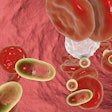
Clinical guidelines on hematology testing in pediatric patients were published in Blood Advances on January 24. The guidelines are part of five recommendations, which also included treatment guidance for those patients, crafted by a task force of the American Society of Hematology and the American Society of Pediatric Hematology/Oncology (ASH-ASPHO).
The two testing recommendations regarding hematologic testing in pediatric patients are as follows:
- Don't perform routine preoperative hemostatic testing in an otherwise healthy child with no previous personal or family history of bleeding.
- Don't order thrombophilia testing on children with venous access-associated thrombosis in the absence of a positive family history.
Untargeted screening has been shown to be ineffective at identifying those at risk of surgical bleeding, the authors noted. Furthermore, severe inherited bleeding disorders are rare, and most patients and family members with severe inherited bleeding disorders are aware of their condition and their family history of the condition.
The guidelines are part of the Choosing Wisely campaign, an initiative of the American Board of Internal Medicine Foundation that aims to promote dialogue on avoiding unnecessary medical tests, treatments, and procedures.
"The ASH-ASPHO Choosing Wisely campaign has identified 5 tests and treatments that expose children and adolescents to potential harm and/or increased cost with limited or no benefit when used in an inappropriate medical setting," wrote the authors, led by Dr. Sarah O'Brien of the Nationwide Children's Hospital in Columbus, OH.
In 2019, the ASH-ASPCO task force formed to make recommendations for a pediatric-focused list to identify tests or procedures "commonly used whose necessity should be questioned and discussed," according to the paper's authors.
When making its final recommendations, the task force abides by the six Choosing Wisely principles:
- Aim to reduce potential harm to patients.
- Be evidence-based.
- Aim to decrease the cost of healthcare.
- Target tests, procedures, or treatments that are common.
- Target tests, procedures, or treatments within hematologist's purview.
- Prioritize recommendations that will have a greater impact.
Three of the five guidelines from the Blood Advances article concerned treatment recommendations for pediatric patients. The first treatment guideline addressed transfusions of platelets in asymptomatic pediatric patients with hypoproliferative thrombocytopenia. The second addressed transfusions of packed red blood cells for iron deficiency anemia in asymptomatic pediatric patients. The third concerned the administration of granulocyte colony-stimulating factor.
All recommendations will be revisited on an annual basis by the ASH Subcommittee on Stewardship and Systems-Based Hematology in consultation with ASPHO, the authors noted. The task force encouraged healthcare providers to consider the guidelines when treating patients.
"We encourage all health care providers to consider the ASH-ASPHO Choosing Wisely guidelines when treating pediatric patients, educating trainees, and considering future quality improvement and research efforts," the authors wrote.


















